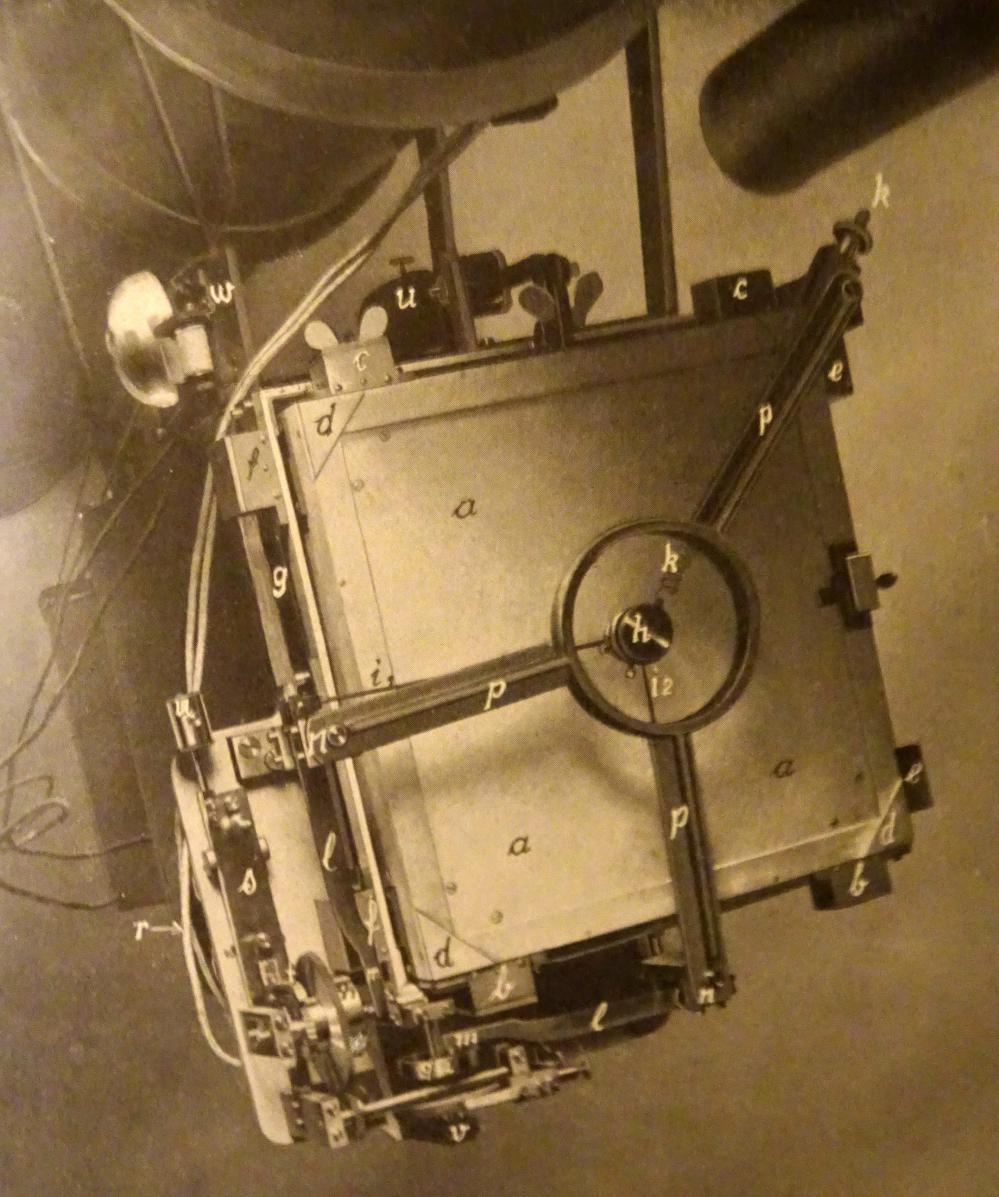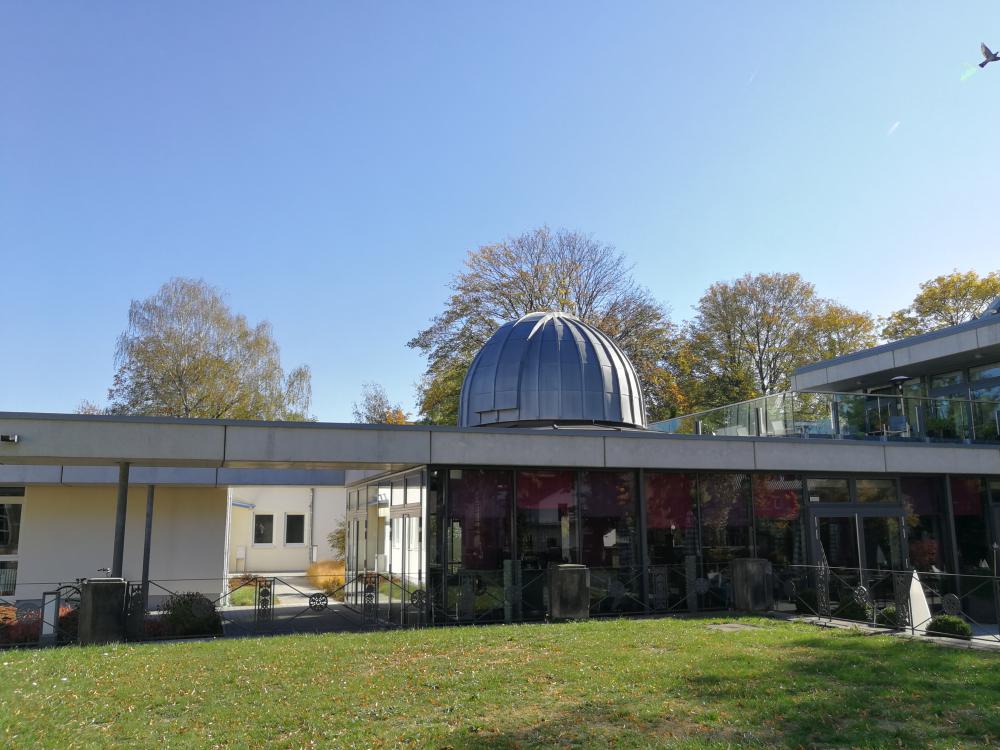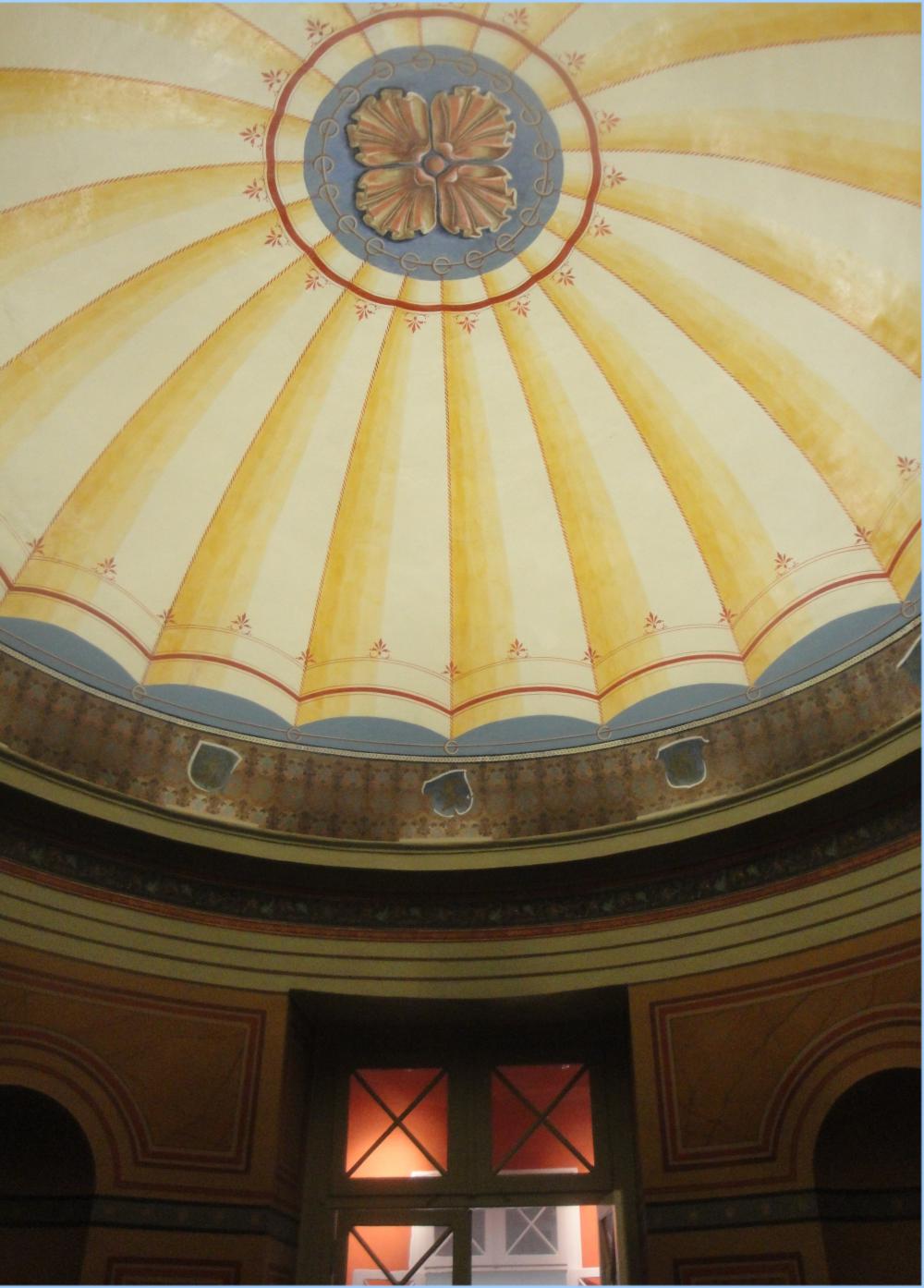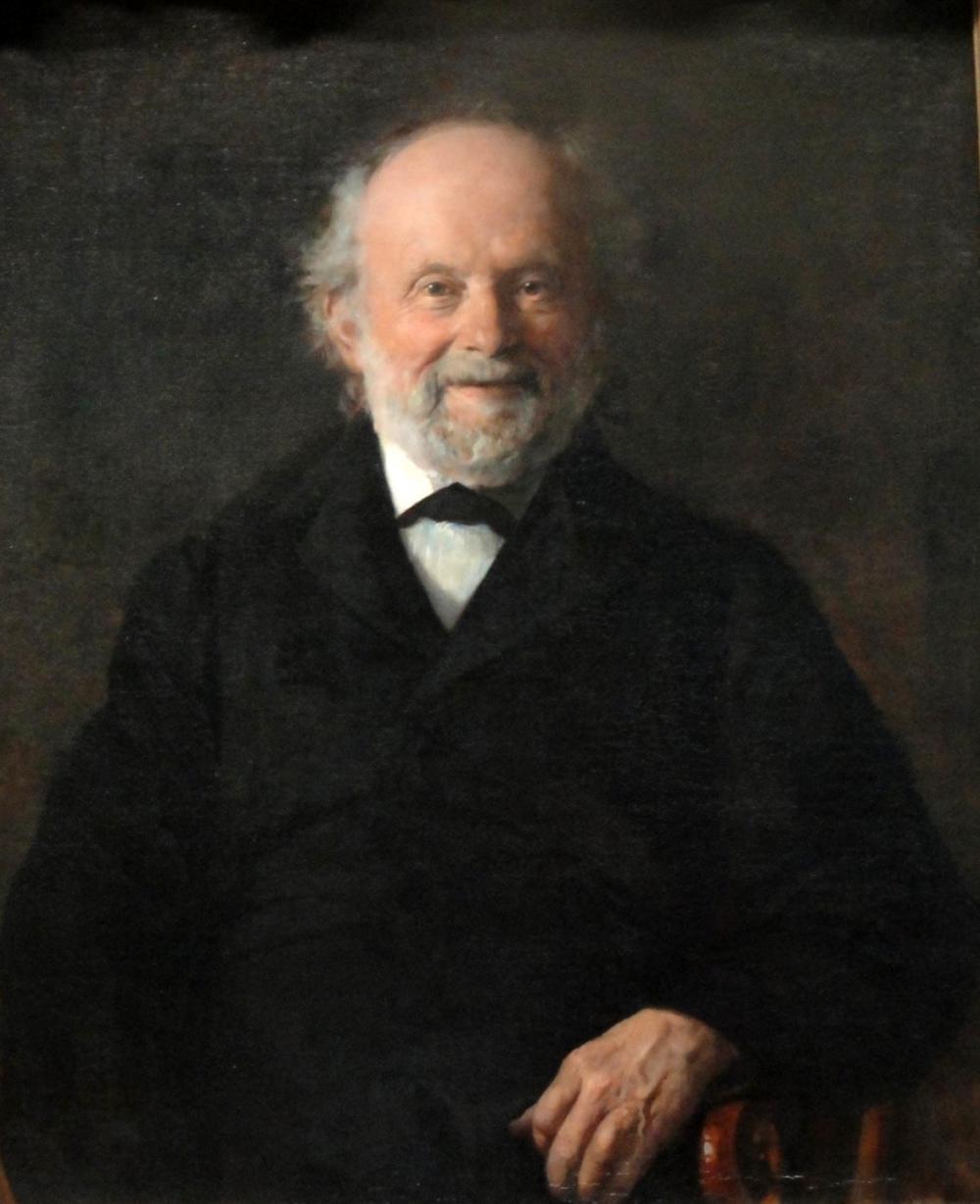
Category of Astronomical Heritage: tangible immovable
Historical Observatory, Göttingen, Germany

Description
Geographical position
Historical Observatory (Historische Gauß Sternwarte),
Geismar Landstraße 11, 37083 Göttingen, Lower Saxony, Germany
Location
51°31’43’’ N, Longitude 09°56’35’’ E, Elevation 162m above mean sea level.
IAU observatory code
528
Description of (scientific/cultural/natural) heritage

Fig. 1. Old Observatory in Göttingen on the city wall (1750) (Etching Heinrich Christoph Grape (1761--1834)
On the occasion of a visit by King George II. (1683--1760) in Göttingen in 1748, Johann Andreas von Segner (1704--1777) was commissioned to build an observatory. This Old Observatory Göttingen existed on the Southern city wall (1750/51). It was aborted in 1822 and finally removed in 1897.
Already in 1751, Tobias Mayer (1723--1762) took over the directorship of Göttingen Observatory. He is famous for his cartography (J.B. Homanns kartografische Anstalt in Nürnberg, 1746--1751), lunar topography, and lunar globes. The highlight of Mayer’s contributions was the solving of the longitude problem; this led to a prize of 3,000 pounds from the British government. His son Johann Tobias Mayer (1752--1830) was director in Göttingen Observatory from 1799 to 1830.

Fig. 2. Göttingen, view from the rampart to the observatory (Friedrich Besemann (1796--1854), 1835)
In 1802, King Georg III. (1751--1834) approved funds for the construction of a new observatory. The Royal Observatory in Göttingen was built in the years 1803 to 1816 according to the design of the university architect Georg Heinrich Borheck (1751--1834): Festigkeit, Bequemlichkeit und Schönheit ("Strength, comfort and beauty") of the building were the maxims of the planning. The building was continued under the Kingdom of Westphalia under Jérôme Bonaparte (1784--1860) until 1813. The observatory was finished by the government building officer Justus-Heinrich Müller (1783--1825) in 1816.

Fig. 3. Göttingen Observatory, built by Georg Heinrich Borheck, 1803 to 1816 (Photo: Gudrun Wolfschmidt)
The U-shaped building with a central dome is erected in classicistic style with high standards for the instruments and their strong fundaments. The model was the Seeberg Observatory in Gotha (1787--1791).
The dome was originally not used for observation purposes, but only as an architectural stylistic device. In 1886/88, building inspector Breymann carried out a reconstruction, including the extension of the attic floor with new windows, widening of the meridian slits to 88cm, and a conversion of the dome into an observatory with a rotating dome by Howard Grubb from Dublin.
There were two wings, two-storey high -- to the rear and north, intended for apartments. The iron dome above the round entrance hall is a construction by Borheck. In contrast to the model, he avoided a thick, annoying pillar underneath and supported the heliometer in the dome on an inconspicuous vault.

Fig. 4a. Göttingen Observatory, entrance hall with vault under the dome (Photo: Gudrun Wolfschmidt)

Fig. 4b. Göttingen Observatory, entrance hall with vault under the dome (Photo: Gudrun Wolfschmidt)
The central building of the Göttingen Observatory is single-storey, with a meridian hall on each side of the entrance hall.

Fig. 5. Göttingen Observatory, meridian slit today (Photo: Gudrun Wolfschmidt)
The vertical meridian slots are inserted into the outer wall and connected across the roof. The meridian slots were set up by Carl Friedrich Gauß (1777--1855), director since 1807, in the years 1818 (eastern hall) and 1819 (western hall); the meridian circles were made by Johann Georg Repsold (1770--1830) of Hamburg and Georg Friedrich von Reichenbach (1772--1826) of Munich (1819). Meridian circles were important for positional astronomy but also for timekeeping. In 1821 two so-called meridian signs (mire) were set up a few kilometers north and south of the observatory. With these markings, visible from the observatory, the meridian circle could be adjusted.

Fig. 6a. Göttingen Observatory, meridian circle, Johann Georg Repsold of Hamburg (1802/1818, photo of 1893, Universitätssammlungen Göttingen)

Fig. 6a,b. Göttingen Observatory, meridian circle, Georg Friedrich von Reichenbach of Munich (1819) (Göttingen, Universitätssammlungen, Photo: Gudrun Wolfschmidt)
In 1919, the Royal Observatory was renamed to University Observatory.
From 1926 to 1932, the meridian halls were converted into a lecture hall in the ground floor and in the first floor new offices by installation of false ceilings and wall panels.
History
The first Observatory in Göttingen was installed in one of the southern city towers in 1750. In 1751, Tobias Mayer (1723--1762) was hired as the first notable astronomer in Göttingen.

Fig. 7. Refractor in the dome of Göttingen Observatory (Photo: Gudrun Wolfschmidt)
Instruments
- Celestial Globe, Willem Janszoon Blaeu (1571--1638) of Amsterdam, 1603
- Portable ring dial, Edmund Culpeper
- Printing plates for the moon globe by Tobias Mayer, 1750/60
- Mural quadrant, John Bird (1709--1776) of London, 1756
- Reflecting Telescope, made by Friedrich Wilhelm Herschel, 1786 (Speculum metal with a diameter of 21,7cm and a focal length of 3m)
- Herschel Reflecting Telescope
- Personal handheld terrestrial telescope from Gauss, Utzschneider, Fraunhofer, Reichenbach of Munich
- Meridian circle, Johann Georg Repsold (1770--1830) of Hamburg
- Meridian circle, Georg Friedrich von Reichenbach (1772--1826) of Munich (1819)
- Vizeheliotrop (Sextant), Edward Troughton of London, 1821, used by Gauß for surveying
- Second type of Heliotrop, 1880
- Small Heliometer, Fraunhofer of Munich, 1813/14
- 16,2-cm-Heliometer, Repsold of Hamburg
- 15-cm-Refractor in the dome
- "Wackelkamera" of Karl Schwarzschild for photographic photometry
Carl Friedrich Gauß (1777--1855) was active with surveying, on a royal commission, from 1820 onwards he continuated the Danish land surveying by the Kingdom of Hanover and thus laid the mathematical foundations of geodesy.

Fig. 8a. Carl Friedrich Gauß (1777--1855) (Gauss Gesellschaft Göttingen)

Fig. 8b. Heliotrop (Sextant) of Gauß for surveying (Photo: Gudrun Wolfschmidt)
In 1833 Gauß and Wilhelm Weber (1804--1891) set up the world’s first electromagnetic telegraph by connecting the observatory with the physical cabinet in Papendiek in Göttingen’s city center. The telegraph was destroyed on December 16, 1845, by a lightning strike.

Fig. 9a. Wilhelm Eduard Weber (1804--1891) (Photo: Gudrun Wolfschmidt)

Fig. 9b. Gauss-Weber-Telegraph, 1833 (Deutsches Museum, BN 35826)
Also in 1833, the Magnetic Observatory (Gauß-Haus) on the observatory grounds was established. In 1902, the Magnetic Observatory was relocated to the former site of the Institute for Geophysics, Herzberger Landstraße.

Fig. 10a. Magnetic Observatory (Gauß-Haus) (Photo: Gudrun Wolfschmidt)

Fig. 10b. Magnetic Observatory (Gauß-Haus), inside (Resultate der Beobachtungen des Magnetischen Vereins, 1836)
After the death of Gauß and Weber, Peter Lejeune-Dirichlet (1805--1859) became acting director of the observatory; however, he was not active in astronomy. After the death of Dirichlet Wilhelm Klinkerfues (1827--1884), Gauss’ former assistant, took over in 1859 as director of the observatory; Wilhelm Schur (1846--1901) followed.

Fig. 11a. Karl Schwarzschild (1873--1916) (Wikipedia)

Fig. 11b. Schwarzschilds "Wackelkamera" (Abhandlungen der K. Ges. der Wiss. zu Göttingen, Math.-Phys. Klasse, N.F., Bd. VIII, I)
With the appointment of Karl Schwarzschild (1873--1916) in 1901, a phase of world-wide top research in the field of theoretical astrophysics began in the observatory.
Later directors of the observatory were Johannes Franz Hartmann (1865--1936), Hans Kienle (1895--1975), Otto Heckmann (1901--1983), and after WWII: Paul ten Bruggencate (1901--1961), Hans-Heinrich Voigt (1921--2017), Rudolf Kippenhahn (1926--2020), Egon Horst Schroeter (1928--2002), Klaus Fricke, Klaus Beuermann and Stefan Dreizler.

Fig. 11c. Directors of Göttingen Observatory from 1751 to 1961 (© Axel Wittmann, 2007)
Directors of Göttingen Observatory
- 1748 to 1751 Johann Andreas von Segner (1704-1777), interim director
- 1751 to 1762 Tobias Mayer (1723-1762)
- 1762 to 1763 Georg Moritz Lowitz (1722-1774)
- 1763 to 1789 Abraham Gotthelf Kästner (1719-1800)
- 1789 to 1804 Karl Felix von Seyffer (1762-1822)
- 1804 to 1807 Karl Ludwig Harding (1765-1834)
- 1807 to 1855 Carl Friedrich Gauß (1777-1855)
- 1855 to 1859 Wilhelm Eduard Weber (1804-1891), interim director,
1855 to 1859 Johann Peter Gustav Lejeune Dirichlet (1805-1859), interim director - 1859 to 1868 Wilhelm Eduard Weber (1804-1891), interim director,
1859 to 1868 Wilhelm Klinkerfues (1827-1884), interim director - 1868 to 1884 Wilhelm Klinkerfues (1827-1884),
1868 to 1889 Ernst Christian Julius Schering (1833-1897),
Leiter des Erdmagnetischen Observatoriums
(ab 1898 "Institut für Geophysik" auf dem Göttinger Hainberg) - 1884 to 1886 Ernst Christian Julius Schering (1833-1897), interim director
- 1886 to 1901 Wilhelm Schur (1846-1901)
- 1901 to 1909 Karl Schwarzschild (1873-1916)
- 1909 to 1921 Johannes Franz Hartmann (1865-1936)
- 1921 to 1924 Bruno Meyermann (1876--1963), interim director
- 1924 to 1927 Hans Kienle (1895-1975), interim director
- 1927 to 1939 Hans Kienle (1895-1975)
- 1939 to 1941 Otto Heckmann (1901-1983), interim director
- 1941 to 1961 Paul ten Bruggencate (1901-1961)
- 1961 to 1963 Alfred Behr (1913-2008)
- 1963 to 1986 Hans-Heinrich Voigt (1921-2017)
- 1987 to 1994 Rudolf Kippenhahn (1926-2020), Klaus J. Fricke (1937-2022)
- 1994 to 1996 Klaus Beuermann (*1937)
- 1996 to 2005 Stefan Dreizler (*1963)
- ab 2005 ? Ansgar Reiners
State of preservation

Fig. 12. Göttingen Observatory with two domes (Photo: Gudrun Wolfschmidt)
The façade of this three-wing building has retained its original appearance, but the adjacent buildings and the interiors were modified several times to meet changing needs during the 19th and 20th century. The colouring of the halls in the main building was redone according to historical plans.
A first renovation of the facades of the observatory was executed in 1994-95.
The main building of the observatory was renovated from February 2007 to November 2008 from scratch (1.8 million Euros) according to the old building plans (restoration to the state of 1888). As far as possible, the original condition was restored according to the time of Gauß and 1886, respectively. The dome, rebuilt in 1886/87, has been completely renovated from 2007 to 2019 with the support of the association "Gauß-Kuppel-Gemeinschaft" and donations by several companies in Göttingen and is now a museum gem and an impressive example of previous research. The geodetic zero point at the foot of the Reichenbach meridian circle was given new visibility through lighting under a glass plate.
Comparison with related/similar sites

Fig. 12. Göttingen Observatory with the central dome (Photo: Gudrun Wolfschmidt)
The design of Göttingen Observatory is based on Seeberg Observatory, Gotha with the U-shaped building and a central dome with a strong fundament (not preserved).
The earliest moveable domes, known in architectural history, can be found in King’s Observatory, Kew (1768), a one dome observatory of the 18th century. Kew Observatory influenced the architecture of Seeberg Observatory, Gotha (1788),
and the two Irish observatories, Dunsink Observatory Dublin (1785), and Armagh Observatory (1790) as well as Göttingen Observatory with the dome.
Threats or potential threats
Fig. 13. Göttingen Observatory with the central dome (Photo: Gudrun Wolfschmidt)
No threats -- The scientifically unique observatory building was renovated, based on the historical model;
this restoration to its original appearance was completed after nearly two years in November 2008.
Present use
In 2005, astrophysics moved to the new buildings of the Faculty of Physics on the Campus.

Fig. 14a. Lichtenberg-Kolleg in Göttingen Observatory (Photo: Gudrun Wolfschmidt)

Fig. 14a. Entrance of Göttingen Observatory (Photo: Gudrun Wolfschmidt)

Fig. 14b. Georg Christoph Lichtenberg (1742--1799) (Photo: Gudrun Wolfschmidt)
The "old" historical observatory (Geismar Landstraße 11, 37083 Göttingen) is used since 2009 by the <i>Lichtenberg-Kolleg,
Institute for Advanced Study</i>, the Doctoral training at the University of Göttingen.
In 2023, the Gauss Society (Gauss-Gesellschaft) got a room for their archive and collections.
Astronomical relevance today
New since 2005: Institut für Astrophysik (IAG),
Friedrich-Hund-Platz 1, 37077 Göttingen

Fig. 15a,b. Hainberg Observatory with solar tower and astrograph, branch of Göttingen Observatory (Amateurastronomische Vereinigung Göttingen e.V., Wikipedia 3, )
A branch institute was built on the nearby Hainberg (180m) in 1929, an 14’’ astrograph (Zeiss UV triplet) , and a Fraunhofer 10’’ guiding telescpope in 1929 under Hans Kienle and Otto Heckmann, a Schmidt camera (1938), and a tower telescope for solar physics in WWII (1944) with a coelostat in a 5-m-dome, and a slit spectrograph with a resolution better than 0.01nm. A 80mm Zeiss refractor with a Coronado solar filter in H-alpha was added.
Modern Branch Institutes of Göttingen
- Branch institute in Locarno since the 1940s:
The idea of using a Gregory Coude-type telescope for solar observations came from Prof. Paul ten Bruggencate. Post-magnification using an ellipsoidal ’Gregory’ mirror instead of the usual hyperbolic ’Cassegrain’ mirror makes it possible to place an aperture in the primary focus that reduces heat and scattered light. The Coudé mount (instead of a coelostat) causes a daily constant telescope polarization, which comes primarily from the two plane mirrors, which direct the light by 90 degrees each in the declination and hour axes.
Such a Gregory telescope was installed at the Locarno station of the Göttingen Observatory in 1959 and, after extensive renovation, was moved to the Teide Observatory on Tenerife in 1984. Mechanical parts and the former quartz optics were later used to install a twin telescope in Locarno, on which new devices for Tenerife can be tested. The Gregory telescope was dismantled in 2002 to be replaced by double Gregory of 1.5m aperture. - Observatorio del Teide on Tenerife (1984):
Now, the Göttingen astronomers have a new type of solar telescope, the Gregory telescope, at the Observatorio del Teide on Tenerife, in a hight of 2400m:
Gregory telescope, 1m ESA, Rastov, Newton, VTT des Izana-Observatorium und 90cm THEMIS. - Since 2000, participation in the Southern African Large Telescope (SALT).
References
Bibliography (books and published articles)
- Biegel, Gers & Karin Reich: Carl Friedrich Gauß. Genie aus Braunschweig - Professor in Göttingen. Braunschweig (2nd ed.) 2009.
- Borheck, Georg Heinrich: "Grundsätze über die Anlage neuer Sternwarten" (Principles for the construction of new observatories).
Ed. by Klaus Beuermann. Göttingen: Universitätsverlag 2005. - Freigang, Christian: Architektonische Bemerkungen zur Göttinger Sternwarte. In: Beuermann, Klaus (Hg.): Grundsätze über die Anlage neuer Sternwarten mit Beziehung auf die Sternwarte
der Universität Göttingen. Von Georg Heinrich Borheck. Göttingen 2005, p. 21--26. - Freigang, Christian: Architektur und Städtebau von der Mitte des 17. Jahrhunderts bis 1866. In: Hoffmann, Dieter (Hg.): "Ganz für das Studium angelegt": die Museen, Sammlungen und Gärten der Universität Göttingen. Göttingen: Wallstein Verlag 2001, S. 188--190.
- Gerardy, Th.: Die Triangulation des Königreichs Hannover durch C.F. Gauß (1821--1844). In: Niedersächsische Vermessungs- und Katasterverwaltung (ed.): C.F. Gauss und die Landesvermessung in Niedersachsen. Hannover 1955, p. 83-114.
- Gohlisch, Torsten & André Sieland: Carl Friedrich Gauß - Spuren seines Lebens, in Lower Saxony: monuments and especially Gauss stones (Gaußsteine), base points for the survey of the Kingdom of Hanover on behalf of King George IV, since 1821. The cuboids usually mark an underground geodetic base point.
- Grosser, Ernst Hartmut & Hans-Heinrich Voigt: Die Universitäts-Sternwarte. In: Hoffmann, Dieter (Hg.): "Ganz für das Studium angelegt": die Museen, Sammlungen und Gärten der Universität Göttingen. Göttingen: Wallstein Verlag 2001, S. 188--190.
- Jäger, F. W.: Nachruf auf P. ten Bruggencate. In: Mitteilungen der Astronomischen Gesellschaft 15 (1962), p. 21-23.
Bibcode 1962MitAG..15...21 - Kienle, Hans: Paul ten Bruggencate 24.2.1901--14.9.1961. In: Die Naturwissenschaften 49 (1962), 4, p. 73-74.
Bibcode:1962NW.....49...73K. doi:10.1007/BF00622019 - Küssner, Martha & Horst Michling: Frühe Darstellungen der Göttinger Sternwarte. Göttingen 1982.
- Mattig, W.: Nachruf: Karl-Otto Kiepenheuer. In: Mitteilungen der Astronomischen Gesellschaft 38 (1976), p. 11-13.
Bibcode:1976MitAG..38...11M - Müller, Peter: Göttingen 1803--1816. In: Müller, Peter: Sternwarten in Bildern. Berlin, Heidelberg: Springer 1992, p. 80-81.
- Oszmer, Sabine: Die Göttinger Universitätssternwarte. Magisterarbeit Universität Göttingen, 1991.
- Reinsch, Klaus & Axel D. Wittmann (Hg.): Karl Schwarzschild (1873--1916). Ein Pionier und Wegbereiter der Astrophysik. Göttingen 2017.
- Sieland, A. (ed.): Correspondenzen der Königlich Hannoverschen Landesvermessung (1821--1844).
Carl Friedrich Gauß, Carl Joseph Gauß, Johann Georg Friedrich Hartmann, Georg Wilhelm Müller et. al. Bände 1-3. Remagen-Oberwinter 2021. - Torge, W.: Geschichte der Geodäsie in Deutschland. Berlin (2. Auflage) 2009.
- Voss, Christine (Redaktion): Die historische Sternwarte. Ein einmaliges Bauwerk der Wissenschaftsgeschichte. Hg. von der Präsidentin der Universität Göttingen. Göttingen 2019.
- Wolfschmidt, Gudrun: Göttingen -- ein Zentrum der Sonnenphysik im 2. Weltkrieg. In: Gauss-Gesellschaft Göttingen - Mitteilungen Nr. 33 (1996), p. 3-10.
- Wolfschmidt, Gudrun (Hg.): Vom Magnetismus zur Elektrodynamik. Herausgegeben anläßlich des 200. Geburtstages von Wilhelm Weber (1804--1891) und des 150. Todestages von Carl Friedrich Gauß (1777--1855). Katalog zur Ausstellung in der Staatsbibliothek Hamburg, 3. März bis 2. April 2005. Hamburg: Schwerpunkt Geschichte der Naturwissenschaften 2005.
- Wolfschmidt, Gudrun: Mondtopographie und Längengrad. In: Tobias-Mayer-Symposium anläßlich des 250. Todestages von Tobias Mayer. Hg. von Erhard Anthes und Armin Hüttermann. Leipzig: AVA - Akademische Verlagsanstalt (Acta Historica Astronomiae, Band 48) 2013, p. 161-210.
- Wolfschmidt, Gudrun: Karl Schwarzschild, der Begründer der theoretischen Astrophysik. In: Physik in unserer Zeit - PhiuZ 47 (2016), Heft 6, p. 294-300.
- Wolfschmidt, Gudrun: Karl Schwarzschild, bedeutendster Nachfolger von Gauß und Begründer der theoretischen Astrophysik. In: Gauss Gesellschaft e.V. Göttingen Mitteilungen (GGM) 54 (2017), p. 9-27.
- Wolfschmidt, Gudrun: Repsold Company as a Global Player -- Meridian Circles from the first in 1802 to the modern computerised in 1967. La société Repsold comme acteur mondial -- du premier cercle méridien en 1802 au système informatisé moderne en 1967. In: Une culture de la précision: les cercles méridiens aux XIXe et XXe siècles, une diversité d’ensembles instrumentaux pour des travaux partagés et convergents. Sous la direction de Daniel Belteki, Julien Gressot, Loïc Jeanson & Jean Davoigneau. Journal Cahiers François Viète - Épistémologie, Histoire, Sciences & Techniques (Nantes Université), Série III (2023), No. 14, p. 101--140 (ISBN: 978-2-493550-05-7).
Online: cahierscfv/3989 (ISSN: 2780-9986), DOI 10.4000/cahierscfv.3989
Links to external sites
- Institut für Astrophysik (IAG), Friedrich-Hund-Platz 1, 37077 Göttingen
- Historic (University) Observatory
- Borheck’s "Grundsätze über die Anlage neuer Sternwarten" (Principles for the construction of new observatories)
- Sammlung der Astrophysik Göttingen (Klaus Reinsch)
- Hainberg Observatorium Göttingen, Astronomie in Norddeutschland
- Amateurastronomische Vereinigung Göttingen und Hainberg-Observatorium
- Interactive Map of the Observatory
- Georg-August-Universität Göttingen, Institute for Advanced Study, Lichtenberg-Kolleg -
Historische Sternwarte, Geismar Landstraße 11, 37083 Göttingen - Doctoral training at the University of Göttingen
- Carl Friedrich Gauß
- Gauss-Gesellschaft e.V. Göttingen - English version
- Istituto Ricerche Solari Aldo e Cele Dacc├▓ (IRSOL) in Locarno
Near IRSOL: Specola Solare Ticinese - The Gregory-Coudé Telescope Teneriffa
- Gohlisch, Torsten & André Sieland: Carl Friedrich Gauß - Spuren seines Lebens
Links to external on-line pictures
no information available
No multimedia content published
Currently there is no multimedia content published for this case study























































